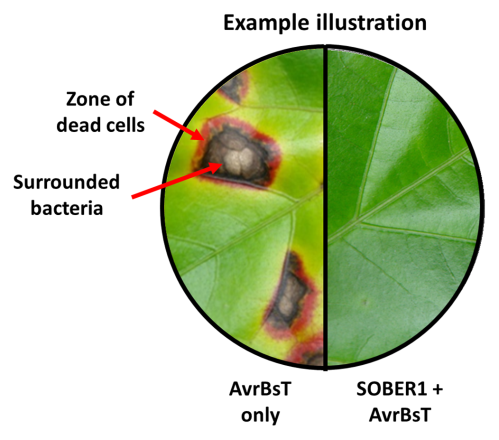 Purdue University - Extension - Forestry and Natural Resources
Purdue University - Extension - Forestry and Natural Resources
Got Nature? Blog
Most terrestrial plants are sessile. This inability to move forces has brought alternative methods to defend themselves. Typically, plants use three basic mechanisms of defense: avoidance, escape or tolerance. A recent work notes that plants may have evolved a fourth method; where healthy tissue is sacrificed in an effort to confine harmful bacteria to a small portion of the leaf.
 Brown spots, if observed on previously unmarred leaves, may result from the plant employing this technique to slow or prevent bacterial spread. Scientists at the Salk Institute have identified a plant enzyme denoted SOBER1 that plants use to seemingly lower their resistance to infection. Future study on the gene may lead to ways to boost natural immunity or contain infections that would otherwise decimate entire agricultural crops and biofuel resources.
Brown spots, if observed on previously unmarred leaves, may result from the plant employing this technique to slow or prevent bacterial spread. Scientists at the Salk Institute have identified a plant enzyme denoted SOBER1 that plants use to seemingly lower their resistance to infection. Future study on the gene may lead to ways to boost natural immunity or contain infections that would otherwise decimate entire agricultural crops and biofuel resources.
Additional experiments involved several model plant species (Arabidopsis, oilseed rape, and tobacco) and evaluated the structure and function of SOBER1 and an immune protein known as AvrBst. The ultimate goal of this work is to understand how bacterial resistance works in plants. The information gained may help identify new methods of improving agricultural and biofuel crop resistance to harmful bacterial infections.
References
A hydrophobic anchor mechanism defines a deacetylase family that suppresses host response against YopJ effectors, Nature Communications, 2017; 8 (1) DOI: 10.1038/s41467-017-02347-w, Marco Bürger, Björn C. Willige, Joanne Chory.
Unusual plant immune response to bacterial infection characterized, ScienceDaily, 8 January 2018, Salk Institute.
Resources
Consumer Horticulture: Fertilizing Woody Plants, The Education Store, Purdue Extension
Shrubs and Woody Vines of Indiana and the Midwest: Identification, Wildlife Values, and Landscaping Use, The Education Store, Purdue Extension
Shaneka Lawson, USDA Forest Service/HTIRC Research Plant Physiologist/Adjunct Assistant Professor
Purdue University Department of Forestry and Natural Resources

Recent Posts
- Report Spotted Lanternfly – Purdue Landscape Report
Posted: April 10, 2024 in Alert, Forestry, Invasive Insects, Plants, Wildlife, Woodlands - Declining Pines of the White Variety – Purdue Landscape Report
Posted: in Alert, Disease, Forestry, Plants, Wildlife, Woodlands - Are you seeing nests of our state endangered swan? – Wild Bulletin
Posted: April 9, 2024 in Alert, Forestry, How To, Wildlife - Cicadas in Spring! – Purdue Landscape Report
Posted: in Forestry, Plants, Safety, Wildlife - New Deer Impact Toolbox
Posted: April 7, 2024 in Forestry, Land Use, Plants, Publication, Safety, Wildlife, Woodlands - 2024-25 Fishing Guide now available – Wild Bulletin
Posted: April 4, 2024 in Alert, Aquaculture/Fish, Aquatic/Aquaculture Resources, How To, Ponds, Wildlife - Help Research Chronic Wasting Disease – Wild Bulletin
Posted: April 3, 2024 in Disease, Forestry, How To, Safety, Wildlife, Woodlands - Indiana Reptiles and Amphibians – IFWOA Webinar
Posted: April 1, 2024 in Forestry, How To, Webinar, Wildlife, Woodlands - Birding through the Seasons – IFWOA Webinar
Posted: in Forestry, How To, Webinar, Wildlife, Woodlands - Look Out for Invasive Carp in Your Bait Bucket – Wild Bulletin
Posted: March 31, 2024 in Alert, Aquaculture/Fish, Aquatic/Aquaculture Resources, Invasive Animal Species, Wildlife
Archives
Categories
- Alert
- Aquaculture/Fish
- Aquatic/Aquaculture Resources
- Ask the Expert
- Christmas Trees
- Community Development
- Disease
- Drought
- Forestry
- Forests and Street Trees
- Gardening
- Got Nature for Kids
- Great Lakes
- How To
- Invasive Animal Species
- Invasive Insects
- Invasive Plant Species
- Land Use
- Natural Resource Planning
- Nature of Teaching
- Plants
- Podcasts
- Ponds
- Publication
- Safety
- Timber Marketing
- Uncategorized
- Urban Forestry
- Webinar
- Wildlife
- Wood Products/Manufacturing
- Woodland Management Moment
- Woodlands